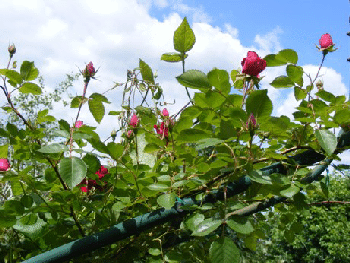Grafted Rose or Rootstock?
Unfortunately, a grafted rose is relatively weak at the point of the graft. If your rose blooms are suddenly different one year, you have probably lost the grafted rose that you bought and the rootstock is blooming. In Northern and Midwest winters grafted roses are easily lost if the bud union is not planted deep enough. Or the rootstock may produce suckers. Since commonly used rootstock is very vigorous, the rootstock plant can overwhelm your graft and even completely take over. Or the short life expectancy of a grafted rose may simply be the problem.
Grafting is a fast and easy way to propagate roses so many nurseries do sell them this way. When you purchase a rose, it is important to be sure it is grown on it’s own roots. Be sure the staff member you ask is well versed in roses and the nursery’s stock, as part time summer help may not really understand the question.
If you have a grafted rose, be sure and plant the graft union at least one or two inches below the soil level. In zones 4 and north, it is common to go even deeper or Minnesota Tip the whole plant before winter. Tender hybrids should be carefully protected from cold, and killing, winters. And keep an eye on the suckers in spring. Rootstock suckers may look a bit different than the grafted rose canes. Remove the soil gently to see if the sucker is coming from below or above the graft union. Rootstock suckers need to be continually removed. Do not prune them off, as many new suckers will be encouraged. With the soil removed, grasp the sucker at the base and pull down and away from the root.
If you have not been paying attention and all of a sudden your rose is producing completely different blooms, you are not alone. Eight years ago I drove quite a distance to purchase two Joseph’s Coat climbing roses, making sure they were own root. They are tender roses so I planted them deep and removed the canes from their arch for winter and covered them. They did not bloom the first year and the following spring the canes were dead, so I pruned them out and new canes finally grew but still did not bloom. I persevered, pulled the canes down and covered them, only to find them dead again the following spring. I gave up but did not dig them out so as not to disturb the clematis planted along side. Each spring a few short canes grew. All of sudden last summer the canes grew like crazy, finally reaching the top of the arch but still did not bloom. The coming winter was extremely mild, the canes survived and low and behold buds this spring!! Well, of course you know what happened. The blooms were not Joseph’s Coat, they were Dr. Huey rootstock. When the pure red blooms opened, I checked on the common rootstocks and the commonly used Dr. Huey has much different canes and thorns than Joseph’s Coat. Since I quit paying attention to the poor rose, I have no idea when the different canes appeared.
In my case, although I am extremely disappointed after getting excited to finally see my Joseph’s Coat (shown above) bloom, I am at least left with a climbing rose that is adequate for the arch. I am also quite disappointed by the nursery who claimed they were own root. Do note that most rootstock is from a climbing rose! So if your grafted shrub dies, instead you may get a vigorous climbing or rambling rose. Dr. Huey does well in most regions and is probably the most commonly used rootstock. In warmer regions Fortuniana is common.

